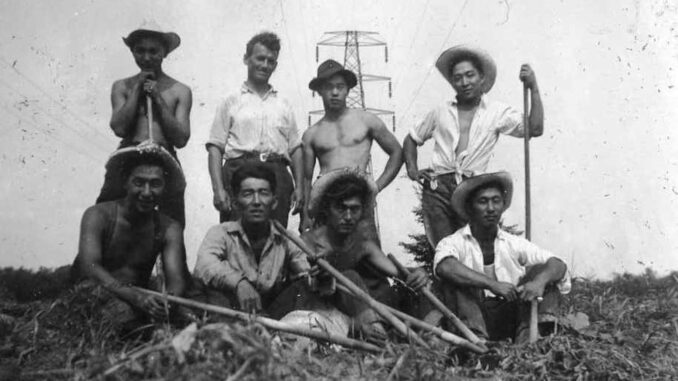
By Chris Gareau, Local Journalism Initiative Reporter, The Middlesex Banner
“He was a real good Canadian.”
That is how presenter Brian Angyal summed up the late Yoshio Shimizu, better known as Yon, at a Glencoe & District Historical Society meeting Jan. 18. It was after listing Shimizu’s long list of accomplishments after his time in an internment camp for Japanese Canadians in Glencoe during the Second World War.
Angyal had a chance to speak with Shimizu shortly before his death in 2016. Shimizu was 18 when he and his older brother left their family in a B.C. internment camp and boarded the train to the camp in Glencoe. All people of Japanese descent were ordered to stay 100 miles away from the Pacific coast in 1942, their belongings confiscated.
Angyal spoke to Shimizu with his wife Norma, whom he had met in Wallaceburg where he settled after earning his university degree in Chemical Engineering from the University of Toronto. Shimizu would get a job at a die-casting company in Wallaceburg before earning an MBA from the University of Windsor through night classes. He would retire in 1985 from Waltec Industries as vice president and general manager. His hometown chamber of commerce bestowed citizen of the year awards on him.
The fairgrounds was where the Crystal Palace was host to about 50 men in one of nine farm camps established in southwestern Ontario. A labour shortage led to the federal government granting Ontario money to take in young men of Japanese descent from B.C. in the summer of 1942.
As Angyal explained, and Shimizu himself wrote in his 1993 book The Exiles and in an essay published by the University of Windsor, the farms in southern Ontario were a welcome sight after the camps in B.C. and Camp Black near Shreiber in northwest Ontario. The following is an excerpt from the essay written.
You have to remember that we had been driven from our homes by racial prejudice in British Columbia, reviled and despised by the bulk of the population, and here in the farmlands of South-Western Ontario, we were welcomed as equals and saviours by the farming population.
That was not an experienced shared by all residents of all camps, Chatham and Dresden were reported at the time as not being as welcoming. Many locals wanted to “keep Canadian British,” explained Angyal.
But Shimizu told of a time in Glencoe where farmers and their families would welcome him into their homes for dinner, and where he could go with friends from the camp to the local Fox theatre to watch movies. Shimizu said leisure time involved gambling in the quarters. He even got to take photos of his time in Glencoe, often getting friends to take silly poses.
The Fox Theatre in Glencoe allowed Japanese workers to attend
Shimizu also developed a friendship with a local paper boy named Alex MacFarlane, who he kept in touch with after leaving and who sent Shimizu photos.
The Crystal Palace was guarded with three people allowed to get out to recreate at a time, but often the young men would flout this rule.
That is not to say it was easy. Sugar beet farming is hard.
“Yon was a city kid not used to farm labour, and he said that was the hardest thing he had to do in the whole time that he was here,” said Angyal.
Wheat and corn were also harvested. They were paid 35 cents an hour for the backbreaking work.
Shimizu and the rest of the workers in the area camps left Nov. 11. He would next go to Kapuskasing in northwest Ontario for a few months before moving to Toronto to work for the war effort and finish his high school. He would end up in Wallaceburg by August 1948, where he would live the rest of his life.
More information on Shimizu and the camps of southern Ontario can be found at the Glencoe & District Historical Society’s Archives building at 178 McKellar Street.
The Society hosts regular presentations on history of the area. Upcoming programs include the U.S. Civil War and Canada, Battle of the Longwood Memorial, and Gaelic Heritage. Their next meeting is Feb. 14 at the Archives.


